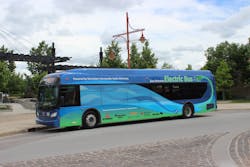As director of the National Alternative Fuels Training Consortium located at West Virginia University, Bill Davis is someone who takes his job seriously.
More people are choosing alternative fuel cars while cities and transit agencies are opting to drop diesel fleets for other fuels, which Davis said helps secure the nation’s energy independence and build a better environment.
A major part of building that cleaner, greener, more secure future means more cities and fleets are looking to electric vehicles and buses to move residents.
“I’ve got four grandkids from five to nine-months on and the work we’re doing is making their life better every single day,” Davis said. “We have to do something because it’s in our best interest to do something.”
Pure electric bus makers like Proterra and BYD are expanding in the North American market while others traditional bus manufacturers like Nova Bus and New Flyer are now marketing their own electric vehicles. The potential upside for electric fleets are big, but getting more of them on the road means a lot more work than just buying buses and putting them into service.
“In Europe, people are looking for 1 kWh per 1 kilometer. I know from Proterra, they used about 1.76 kWh for 1 mile of use so that means for approximately 260-300 kWh battery, you could roughly expect to get 150 miles from that,” said Peter Gunia, BD and sales manager-Americas, vehicle business unit for Saft. “That allows autonomy for extended range opportunities on these buses, to keep it out the entire day and bring it back for recharging now makes it very, very feasible for electric buses to be the future.”
Power from the source
Olivier Amiel, vehicle business unit director for Saft, said lithium ion batteries are using three different types of chemistry for electric buses, which all have different applications. Iron phosphate batteries are the most popular in this technology with companies like BAE putting them as part of their drive systems while bus manufacturers like New Flyer, Alexander Dennis and Volvo using them in applications; Nickel Magnesium Colbalt (NMC); and Lithium Titanate batteries, which are used by companies like Proterra for fast charging buses.
Iron Phosphate batteries are the most widely used due to their safety, while NMC has a higher energy density and Lithium Titanate recharges rapidly.
“It’s has a good cycling ability, however, the drawback can be on energy density,” Amiel said. “If it’s used in a fully electric bus, due to the energy density, you can only work with the technology if you’re able to recharge it frequently.”
Amiel said Saft built a simulation tool to model the life of a battery for use in a specific application because the battery technology is dependent not only on the vehicle it’s going into, but the route it will run, the climate it will work in and workload demand. High temperatures can shorten the life of a battery in an electric bus, while cold climates like northern Canada impact the power management, so it’s important to consider the entire battery system of the bus.
Power capacity also needs to be determined in picking battery technology for your route and vehicles, Amiel said, if you plan to implement power recovery systems from the braking system of the bus. The battery needs to handle a high amount of recharge energy when the brakes are applied in such an application, so a potentially very high current will be coming back at the battery.
“You need to do a battery sizing and simulation for which technology you’re going to select because you need to have the appropriate technology and the right sized battery for a specific application for that vehicle and that it achieves its life cycle requirements,” Gunia said. “To reach each of those criteria is very critical.”
Amiel said within the next five years he doesn’t see the battery technology moving away from lithium ion, rather companies will improve the technology to capture more energy within the same box. After 2020, the industry will start to think about new chemistry and compounds to increase energy density.
“Whether it’s a bus or a cell phone or a camera, any battery out there, it’s a race to put more and more energy into the same volume,” he said. “So we believe that we should be able to double the energy density, which means we should be able to get twice as much energy into the same weight or volume within the next 5-10 years.”
Davis said battery and ultracapacitor technology continues to improve, but creating the breakthrough technology to revolutionize it means spreading the word about the fuel sea change.
“I speak to a lot of high school and middle school students about what we do and I know sitting in a seat in a classroom right now is the mind that has thought process to make that technology and to take it to the next level,” he said.
Rethinking Refueling
About six years ago, the provincial government of Manitoba decided to undertake an initiative to explore the potential for electric vehicles in order to increase green technology and develop commercial opportunities. The plan brought together a consortium between Mitsubishi Heavy Industries, New Flyer, local utility Manito Hydro and Red River College.
The consortium came up with its first electric bus prototype in 2012 after just two years of work fitting the electric motor onto a New Flyer bus. After further development and planning, the consortium eventually took the concept into service when Winnipeg Transit launched the buses along a 40 kilometer route in November, running from Winnipeg Richardson International Airport into the downtown area of the city.
“The charging aspect took longer. We really didn’t have a mature charging system until the summer of 2014,” said Dale Friesen, manager of the industrial and commercial solutions division of Manitoba Hydro. “The reasoning behind that was simple. We were attempting to do something that hasn’t been done very often. We were trying to build a very high capacity rapid charging system used in route and installed curbside and we initially told people we wanted a 300-500 Kwh charging system, so we got a lot of very blank stares.”
One big issue in developing a charging system Friesen said was there really are no such standards, so developing a system means working from the ground up while also determining the type of system you’re going with — bigger batteries with less room for passengers, or smaller batteries with faster in route charging.
Amiel said charging strategy is important for electric bus usage because there will always be demand for nigh charging, but there can be plans for opportunity charging along the route to get partial recharges, then fully recharging at night.
Friesen said they learned the charging strategy for electric buses is dependent on how the transit authority will use them. Because they only need routine maintenance and washing, they can stay in service 21 hours per day with in route charging.
“When you’re looking at charging strategies, at some point I’ve had to always make the point that if you want to build an all-electric transit bus and on the operations side you wanted to use it in the exact same way you would a traditional diesel bus…you’re going to leave a huge amount of benefit on the table and you’re not going to be able to capture the full benefits of the electric bus,” Friesen said.
Due to the load put on the grid from charging, Friesen said it’s important the transit authority and power authority determine the charging strategy because if lots of buses are charging at the same time it will add to demand on the system.
“I think the lesson, the thing we really learned out of this whole experience is that there’s no perfect solution and that whenever an electric vehicle, or electric buses are put into service it has to be designed to have enough flexibility so you can meet some of the local constraints,” Friesen said. “You may put electric buses in Winnipeg, or Chicago, or Minneapolis or Toronto, there will be different physical constraints for each utility in those jurisdictions even though there are a lot of similarities.
“It might depend on where the garage is located or where the route is compared to the utility infrastructure. For me, to place a 500 KwH curbside charger in a residential area might be very challenging if I don’t have the infrastructure in place in the ground or it could be the service load in the transit garage.”
Siemens has worked with Volvo Group for more than two years on developing fast charging systems for transit buses in order to recharge smaller batteries in 5-10 minutes. Since the collaboration began, they’ve worked to get systems online in areas like Hamburg, Germany and Stockholm, Sweden, with plans to couple pure electric Nova buses with fast chargers for Société de transport de Montréal (STM) to deploy them in Quebec. Leah O'Dwyer, business development manager for Siemens, said none of those projects had major issues with putting additional load on the grid and steps were taken to make it an open standards technology so any type of bus can be fit to use the chargers.
There is potential to use pure electric buses in bus rapid transit systems, O'Dwyer said it creates more questions and challenges with determining battery size given the length of the route compared to a traditional bus line.
“This is certainly the right direction for BRT to go, but we possibly may be looking at intermediary stops of 90-120 seconds long the route,” she said.
Installing a 300-500 KwH charger sitting curbside also brings in more issues, Friesen said because that’s the equivalent load drawing from the grid as a large commercial building or small industrial building. Some may opt for charging overnight instead, but that creates issues because if you have 300 buses all charging at 100 KwH overnight, Friesen said that’s the equivalent load as large steel mill.
“Those are some really big load and a lot of transit garages are located in residential or light commercial areas and you would have to run a transmission line into that location and building a transmission line into a residential neighborhood is almost legally impossible,” he said.
And building public charging stations means more than just meeting power needs.
“One of the big parts of one of these whole projects that I’m not sure is given enough credence, but it always comes up is the whole idea of the packaging, what this equipment looks like, what does the enclosure look like,” O’Dwyer said. “There is the civil works impact and in communities these become really big issues, so it’s important going forward for anyone to address those concerns.”
In the charging system developed for Winnipeg, the bus rolls to the charger, a unit connects above the bus and AC power is converted to DC power on the bus and charging at 300 KwH takes place for about 6 minutes. They’re working on a 400 KwH system that will reduce charging time to four minutes, but faster charging means more heat, which causes issues with batteries.
“The utility really does play an important role in helping decide what the appropriate configuration for an electric vehicle or electric transit bus is because as an energy supplier, we’re not configured the same way as your local gas station or transit refueling station,” Friesen said.
Davis said he doesn't think there are any cities right now in North America ready for a mass change to electric vehicles due to the sheer infrastructure needs. Buses need charging stations or fast charging stations along their routes and getting light duty vehicles in mass service — like an all-electric taxi — fleet would requires lots of charging stations.
Building this infrastructure means making a significant investment, but Davis said it’s important the federal government give incentives to fleets and cities to make the switch. Blowback from regulations in the 1980s and 1990s regarding natural gas and propane should be heeded by the electric vehicle industry.
“City governments and county governments, they’re the ones who are going to have to take the leap,” he said. “The federal government can come into play, but I don’t think it’s needed in the form of regulations or laws. I think one of the things is that it’s important for the federal government in helping us to move to where we need to be, not to regulate us to do it.
“Give us the incentives we need to do this and to do what we need to do.”
Friesen said Manitoba Hydro needed to be part of the project so it can understand what impact electric commercial vehicles can have on the region’s grid as they’re developed and put into service. Infrastructure is needed from the utility for electric buses, along with charging plans.
“Being an energy provider to transportation needs isn’t something utilities have traditionally done,” he said. “Some do provide power for trolleybuses, but that’s more in line with what we traditionally do in stringing poles and wires and the load was a constant load on the system all the time. It wasn’t an intermittent load and now with charging electric vehicles we now have an intermittent load so there are a number of factors we have to account for.”
Friesen said installing a high capacity curbside charge can be difficult given its sheer size. The units are 8 feet wide, four feet deep and 8 feet tall and you also need transformer. Traditionally these are installed on concrete pads, but in climates like Winnipeg with extreme temperatures and a clay soil there is lots of movements so the pad will move causing issues. Friesen said Manito Hydro installed the units using fiberglass tubs filled with sand and gravel buried into the ground to provide flexibility and make sure cables are not locked in place.
“We were using the same knowledge we have and used it to design these installations for the high capacity charges and using these same approaches it created a huge cost savings for the installation,” he said. “We took our utility experience with transformers and we did it with high capacity charging stations so it was the utility directly benefiting the project.”
Training and Safety Education
Getting past myths surrounding electric vehicles means educating the public on the technology, Davis said, such as taking part in public outreach campaigns like the Clean Cities Coalition’s Alternative Fuel Vehicles Day so the public at large can see the benefits and the need to drop fears.
“For riders, there’s really no concern to them riding on these electric buses other than getting on and paying their fares. Yes, they’re different vehicles, but the differences don’t apply to them,” Davis said. “It’s better for the environment and medically it has been proven that electric vehicles are better for their upper respiratory system.”
Local utilities also understands security with transformers so Friesen experience showed ways to make sure no one harms to tries to kill themselves with the unit. The system doesn’t start moving power until it’s connected to the bus and the bus communicates the need for the charge. The rest of the system is encased in steel. In the event the bus starts leaking power to the ground, the charging system shuts off in milliseconds to keep riders from harm’s way.
“The components they grab onto and touch when they enter the bus are also physically isolated from the electrical system," Friesen said. “They’re insulated mechanically and that’s to ensure they never become charged, so that’s a way to protect the passengers in the event of any potential battery failure.”
Davis said the NAFTC developed a training program so technicians and instructors from across the country can learn how to fix and maintain electric vehicles. About 400 technicians and 50 instructors have gone through the program, but like most things in the automotive industry, he said it’s a slow process of moving it out to a wider audience.
“In actuality, as I’ve told someone before when it comes to alternative fuel vehicles is that once you’ve trained somebody for electric vehicles, that person pretty much knows how to work on them across the board for all different models,” Davis said. “The technology you’re dealing with applies across the board.”
Davis said his organization also put together a training program for first responders so they can properly respond to emergency situations involving electric buses and cars. As first responders enter the program, he said it’s not uncommon for many of them to ask questions about popular myths they hear, such as they can get electrocuted if responding to an incident with an electric vehicle in the rain or if a battery breaks open.
“I won’t be mentioning the publication, but a major city newspaper actually published a newspaper article about a hybrid vehicle that went into a river and when the first responder got into the river they were electrocuted,” Davis said. “That answer is no. There are too many safety factors so part of what we have to do is dispel the myths of electric vehicles and we have to educate them specifically on those vehicles.”
Gunia said the move towards electrification is still an economic factor, but for prices coming down, it makes it a more attractive option for more North American transit agencies.
“I think with regards to the types of vehicles, with the electric buses, you have the brand new, high performace, top-of-the line bus for $800,000 to $900,000 versus the refurbished buses that are completely new inside and with battery power in the range of $600,000 to $650,000,” Gunia said. “And in the U.S., the federal government subsidizes 80 percent of the purchase for one of these units.”

Joe Petrie | Associate Editor
I came to Mass Transit in 2013 after spending seven years on the daily newsbeat in southeastern Wisconsin.
Based in Milwaukee, I worked as a daily newspaper reporter with the Waukesha Freeman from 2006-2011, where I covered education, county and state government. I went on to cover courts for Patch.com, where I was the main courts reporter in the Metro Milwaukee cluster of websites.
I’ve won multiple awards during the course of my career and have covered some of the biggest political events in the past decade and have appeared on national programs.
Having covered local government and social issues, I discovered the importance of transit and the impact it can have on communities when implemented, supported and funded.






